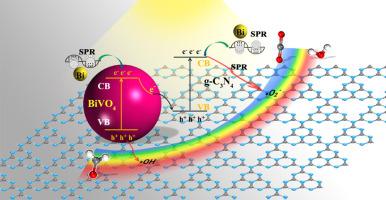Journal of Colloid and Interface Science ( IF 9.4 ) Pub Date : 2020-12-29 , DOI: 10.1016/j.jcis.2020.12.087 Meiting Song , Yuhang Wu , Chunfang Du , Yiguo Su

|
It is crucial to develop more effective photocatalysts in the field of clean environment. In response, the S-scheme BiVO4/g-C3N4 heterojunction modified by in situ reduced non-noble metal Bi nanoparticles was used to synergistically degrade formaldehyde under full spectral irradiation. The results, that investigated by careful characterizations and density functional theory (DFT) calculations, proved that BiVO4/g-C3N4 form an S-scheme heterojunction, which can effectively improve the separation efficiency of photogenic carriers and maintain the original strong redox capability of semiconductor materials. The SPR effect of Bi elemental substance enhanced the optical response and provided more oxidative species. Thus, the photocatalytic activity of BiVO4/Bi/g-C3N4 was significantly improved through their joint efforts, that the degradation efficiency of HCHO (800 ppm) for 6 h is 96.39% under 300 W Xenon lamp without filter with the pseudo-second-order rate constant of 4.16 ppm−1·h−1 and CO2 selectivity of 98.41%. Surprisingly, the degradation efficiency also reached to 49.35% and 32.23% under visible and near-infrared light irradiation, respectively. Moreover, we also tested its photocatalytic decomposition effect on formaldehyde in coatings, indicating that it has a broad prospect in future coatings applications. This study may provide an expected photocatalyst, an efficient non-noble metal modified S-scheme heterojunction, to degrade volatile organic gases under a broad spectrum light.
中文翻译:

S型钒酸铋和氮化碳与双功能铋纳米粒子相结合,可在全光谱下有效去除甲醛
在清洁环境领域开发更有效的光催化剂至关重要。作为响应,通过原位还原的非贵金属Bi纳米粒子改性的S方案BiVO 4 / gC 3 N 4异质结在全光谱照射下用于协同降解甲醛。通过仔细的表征和密度泛函理论(DFT)计算研究的结果证明,BiVO 4 / gC 3 N 4形成S型异质结,可以有效提高光生载流子的分离效率,并保持半导体材料原有的强氧化还原能力。Bi元素物质的SPR效应增强了光学响应并提供了更多的氧化物质。因此,通过共同努力,BiVO 4 / Bi / gC 3 N 4的光催化活性得到了显着提高,在不带假过滤器的300 W氙灯下,HCHO(800 ppm)6 h的降解效率为96.39%。二级速率常数为4.16 ppm -1 ·h -1和CO 2选择性为98.41%。令人惊讶的是,在可见光和近红外光照射下,降解效率也分别达到了49.35%和32.23%。此外,我们还测试了其对涂料中甲醛的光催化分解作用,表明其在未来涂料应用中具有广阔的前景。这项研究可提供一种预期的光催化剂,一种有效的非贵金属改性的S方案异质结,可在广谱光下降解挥发性有机气体。















































 京公网安备 11010802027423号
京公网安备 11010802027423号